Pilot Short S-150SS Fountain Pen With Telescoping Section c. 1966-1969
by Jim Mamoulides, August 16, 2024
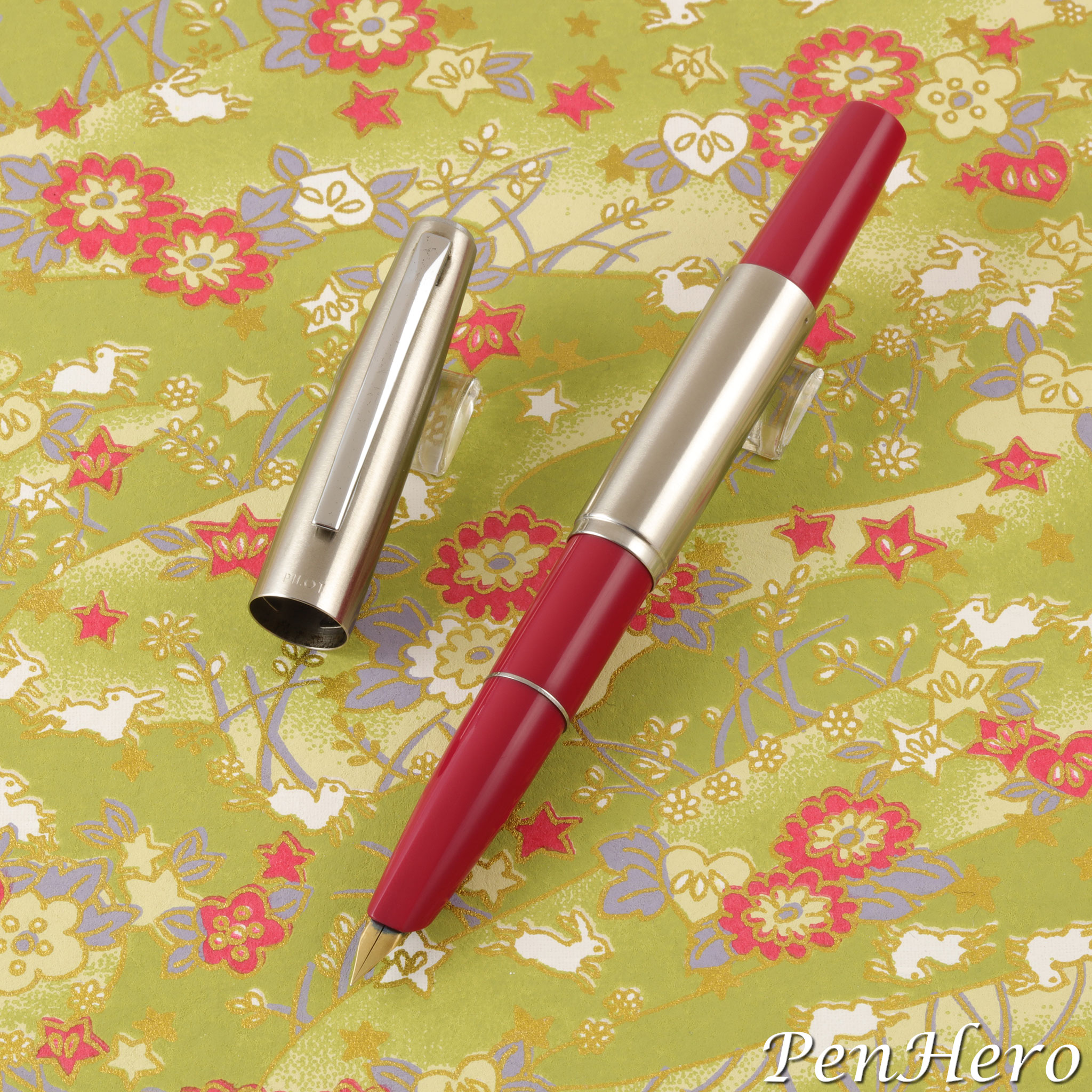 Pilot Short S-150SS fountain pen red c. 1966-1967
Pilot Short S-150SS fountain pen red c. 1966-1967
Short and Sweet
If there ever was a pen with an appropriate and descriptive name, it would have to be the Pilot Short fountain pen. There’s very little information in English about these plastic and steel 4 5/16 inch long capped pens that precede the introduction of the famous, and also short, Pilot Elite S. The Pilot Elite S, introduced in 1968, has a charming feature. It’s short and compact when capped and it becomes long enough for comfortable writing when the cap is posted on the end of the barrel. This aspect of the Elite S design is intentional as the section is too short for writing without the cap posted. To make this work, the cap and section are both quite long for the size of the pen.
The Pilot Short becomes longer for writing in much the same way, but with an added feature: the section can be extended by pulling on it, which increases the posted length from 5 1/16 to 5 5/8 inches, making it a very compact pen closed and still a comfortable pen to write with. Because of this quirky feature, the Pilot Short pens are often called “short telescoping” or “long-short.” The cap proportion to the barrel is less dramatic than on the Pilot Elite S, making the Pilot Short the one with the shorter cap.
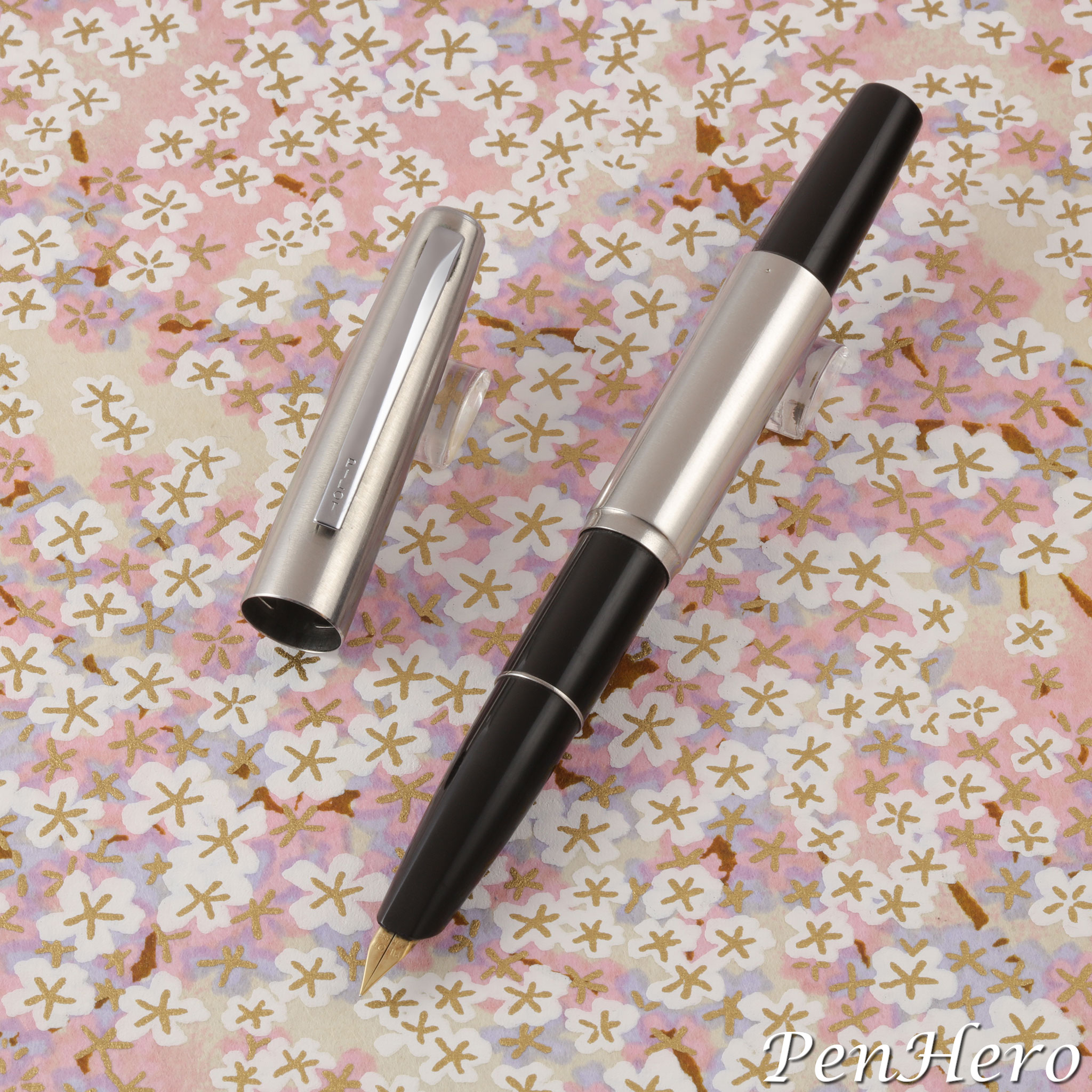 Pilot Short S-150SS fountain pen black c. 1967-1969
Pilot Short S-150SS fountain pen black c. 1967-1969
The earliest of the many Japanese pocket-size type pens was the Sailor Mini, introduced in 1963. It singularly influenced all following designs. Sailor and other Japanese pen makers, including Ferme, Morison, Pilot, Platinum, Teikin, and others made pocket-size pens in a large variety of styles and decorations into the 1980s. Some sources say pocket-size pens and the Pilot Short in particular may have been initially marketed to students. The Elite was recently revived by Pilot as the Elite 95S in 2013 to celebrate the company’s 95th anniversary.
You Have to Know the Code
Let's talk about numbers and codes for a minute. The Pilot Short has two different markings that tell a story of when the pen was made and when the nib was made. The model number itself also describes the pen. Let's start with the model numbers. There are five variations of the Pilot Short fountain pen with this telescoping section feature and what has been collected about the model names, numbers, dates and features was provided by Bruno Taut from very detailed work compiled by a Japanese pen collector named Mr. Fukuyo.
The model number is descriptive of the pen. First are one or two letters, S for Short and B if it is a Short balance type with rounded ends. This is followed by a three digit number for the price in yen, determined by adding one more zero to the end of the number. The next letter indicates the cap and sleeve material, S for steel, M for anodized aluminum, and G for gold plated. The last letter indicates what kind of cartridge is used with S for a single cartridge and W for a double cartridge. The Pilot Short in this article is a model S-150SS, a Short pen priced at ¥1500 with a steel cap and barrel sleeve that uses a single cartridge.
The list of Pilot Short telescoping models (models other than S-150SS to be covered in future articles):
- S-150SS: Matching color plastic barrel and section with a lightly brushed plain steel barrel sleeve and cap that has a 1mm flat cap top (subject of this article)
- S-200SS: Same as the S-150SS but with a gold plated clip
- S-300SS: Matching color plastic barrel and section with a checkered engraved steel barrel sleeve and cap that has a 2mm flat cap top
- S-400GS: Matching color plastic barrel and section with checkered engraved gold plated metal barrel sleeve and cap that has a 2mm flat cap top
- SB-200SS: Matching color plastic barrel and section with a lightly brushed plain steel barrel sleeve and cap and a rounded matching color plastic cap top and rounded barrel end
One pen in the Pilot Short line does not telescope:
- SB-100SS: Matching color plastic barrel and section with a lightly brushed plain Alumite (a Pilot brand name for an anodized aluminum alloy) barrel sleeve and cap with a rounded matching color plastic cap top and rounded barrel end
Pilot called the flat top pens “vest style” according to Bruno Taut’s October 14, 2021 article “Short.” Retail prices for the various Pilot Short models were ¥1000 to ¥4000, with the Alumite pen being the cheapest, likely because it lacks the telescoping feature, and the gold plated pen being the most expensive.
Two additional versions of the Pilot Short exist, photographed in Fountain Pens of the World by Nakazono Hiroshi. One appears to be the S-150SS with a transparent cap and barrel and one appears to be the S-400GS with a cap resembling the one on the Pilot Super Ultra pen of 1959. The text with each pen is simply descriptive with no indication that these are prototypes, a demonstrator, or a short run production pen.
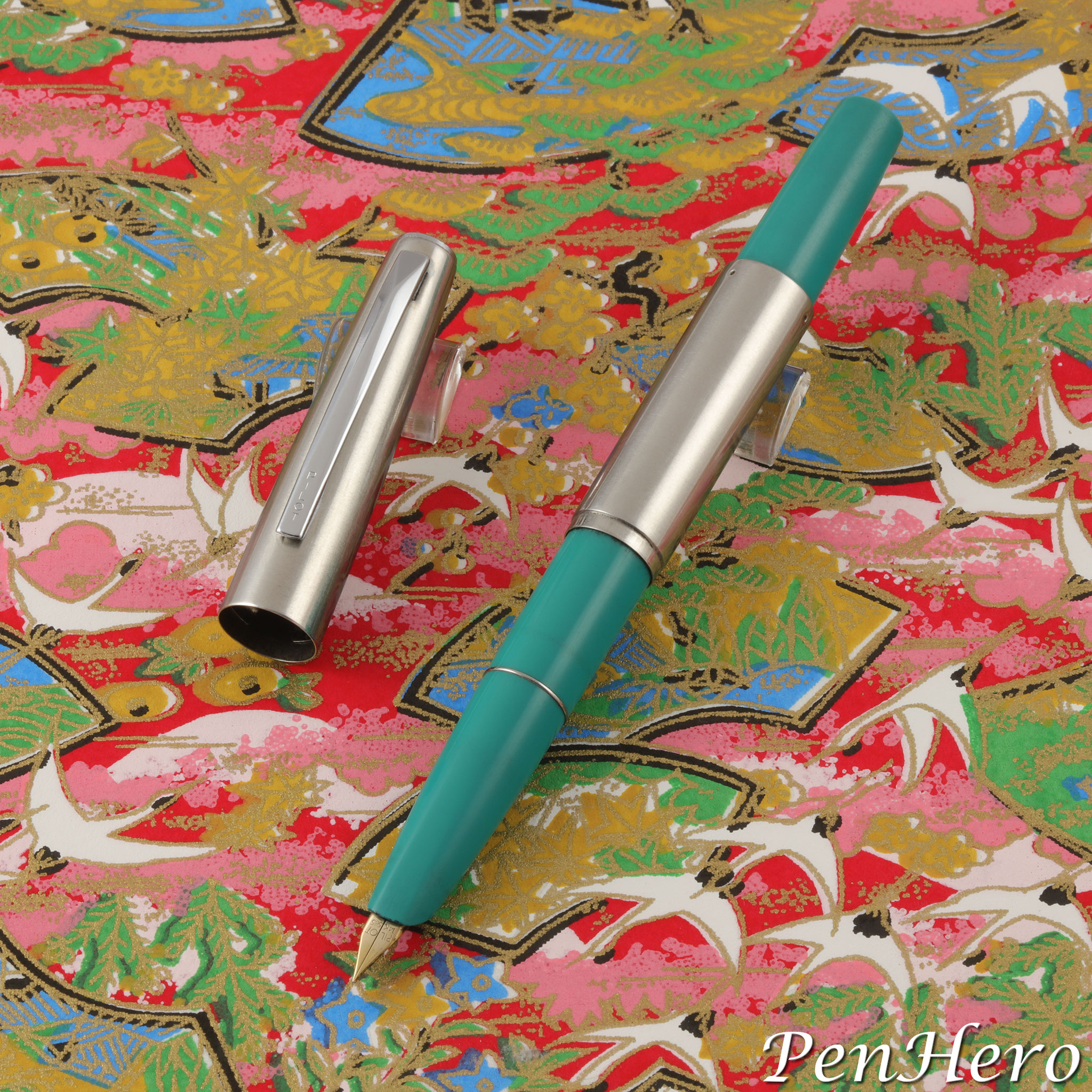 Pilot Short S-150SS fountain pen aqua c. 1967-1969
Pilot Short S-150SS fountain pen aqua c. 1967-1969
I’ve only seen two Pilot company images featuring the Pilot Short, one from 1967 and one from 1968. The first is an advertisement showing this Pilot Short model in red held by a female hand with red nail polish. The second is a card showing a smiling pretty girl in a kimono holding a pen with an image of this Pilot Short model in red in the corner. Those at least narrow the dates for these pens to 1967 and 1968, but that's hardly conclusive. The Short pens are not mentioned on Pilot’s website other than appearing in the 1967 advertisement mentioned above. Readers may note that Fountain Pens of Japan says the Pilot Short was introduced in 1968, but there is much more information that indicates that the production date begins in 1966. Wai Tat Jerry of Pocket Pen Chronicle blog says based on his research, the pens “started production in November 1966.” I’m inclined to agree on that year as the first year for Pilot Short pens given what I’ve been able uncover.
By date coding pens and nibs Pilot helped later collectors figure out more about when they were made. Examples of the model shown in this article, the Pilot Short S-150SS, are reported by their owners with date codes from 1966 to 1969. The three shown in this article have 1967 and 1968 date codes. I don’t know of any examples of this particular model with date codes after 1969, but that does not mean they don’t exist.
Let's break down the date codes on the barrel end. It would be nice to have the Pilot catalogs from 1966 to 1969 to sort and verify the models and prices, but enough pens exist with date codes that collectors to get a good fix on what was made when. This model will have a date code stamped on the barrel end near the metal sleeve. The date code is two letters and two numbers, such as HO 16. The first letter is the year, starting with 1960 = A. The second letter is the month, by manufacturing plant, with A-L for the Hiratsuka factory in the Kanagawa Prefecture, and M-X for the Tokyo factory in Shimura, Itabashi ward. January in each case = A or M. The number = the day of the month. Therefore, HO 16 = a pen made at the Tokyo factory on March 16, 1967.
Finally, let's look at the date codes that appear on the nibs. The nibs on the Pilot Short have a date code stamped on the end opposite the slit and tip. It's hidden from view and requires removal of the nib to see it. The date code is one letter followed by three or four numbers, such as H1268. The first letter is the factory, with H for the Hiratsuka factory in the Kanagawa Prefecture, and T for the Tokyo factory in Shimura, Itabashi ward. The number = the month as the first one or two digits followed by the year as two digits. Therefore, H1268 = a nib made at the Hiratsuka factory during December 1968. Collectors report that most nibs have Tokyo factory marks. The earliest nib production date reported is November 1966. The earliest nib production date where the nib hallmark is visible is reported as April 1967.
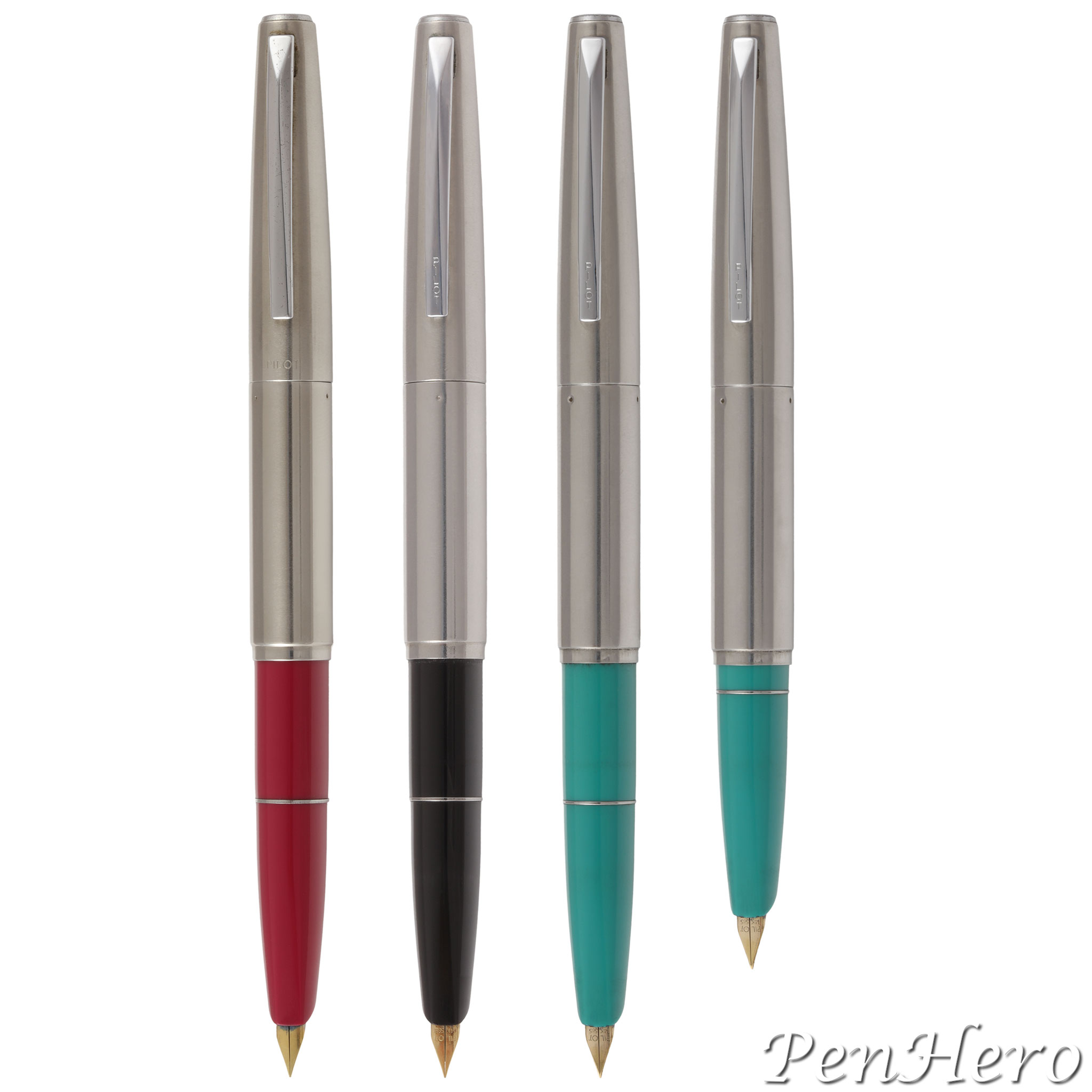 Pilot Short S-150SS fountain pens in red, black and aqua, posted with the cap on the end of the barrel, showing how much the pen extends
Pilot Short S-150SS fountain pens in red, black and aqua, posted with the cap on the end of the barrel, showing how much the pen extends
Identification Guide and Features: Pilot Short S-150SS
The Pilot Short S-150SS fountain pen with the telescoping section feature has a plastic body and matching color section with a lightly brushed plain steel body sleeve and cap. The cap is topped with a short 1mm flat steel cap top. The section will extend by pulling it. There are three cap versions: one with a plain chrome plated clip with PILOT stamped just below on the cap, a second one with a chrome plated clip stamped PILOT with with PILOT stamped just below on the cap, and a third one with a chrome plated clip stamped PILOT with no markings on the cap below. The second version, based on reported date codes, appears only briefly in mid 1967. The earliest pens have a gold nib where the hallmarks are not visible, which changes in mid 1967, possibly April of that year, to a visibly hallmarked nib. A 2 5/16 inch long, squeeze converter fits these pens. Only three colors of this pen have been observed.
- Plastic section and barrel in black, red, blue, and aqua (or turquoise) with a lightly brushed steel sleeve over the barrel and a steel cap
- Chrome plated clip with PILOT stamped on the cap below, chrome plated clip stamped PILOT with no markings on the cap below, or both cap and clip stamped PILOT (see above paragraph)
- Section telescopes by pulling it, increasing the pen length with the cap posted on the end of the barrel
- Cap snaps on with a click
- Gold nib stamped PILOT over 14K 585 or plain (where the PILOT and 14K 585 mark are on opposite sides and not visible)
- Nib sizes unknown, most likely extra fine, fine and medium were offered
- Cartridge / converter filler that uses Pilot standard cartridges
- About 4 5/16 inches (111mm) long capped, 5 1/16 (129mm) with the cap posted on the end of the barrel, which can extend to 5 5/8 inches (145mm)
- Price stickers on this model are printed PILOT over Short over the price, and show a retail price of ¥1500
Performance
What’s the appeal of these tiny pens?
I am definitely attracted to quirky, obscure, or gimmicky pens and this one definitely pushes all those buttons. Small compact pens that when capped become full size pens were popular in Japan in the 1960s and 1970s and are a niche that a lot of today’s pen collectors focus on. They were made by a lot of pen companies and came in all sorts of styles and decorations. The Pilot Short with its telescoping section is one of the more unusual types.
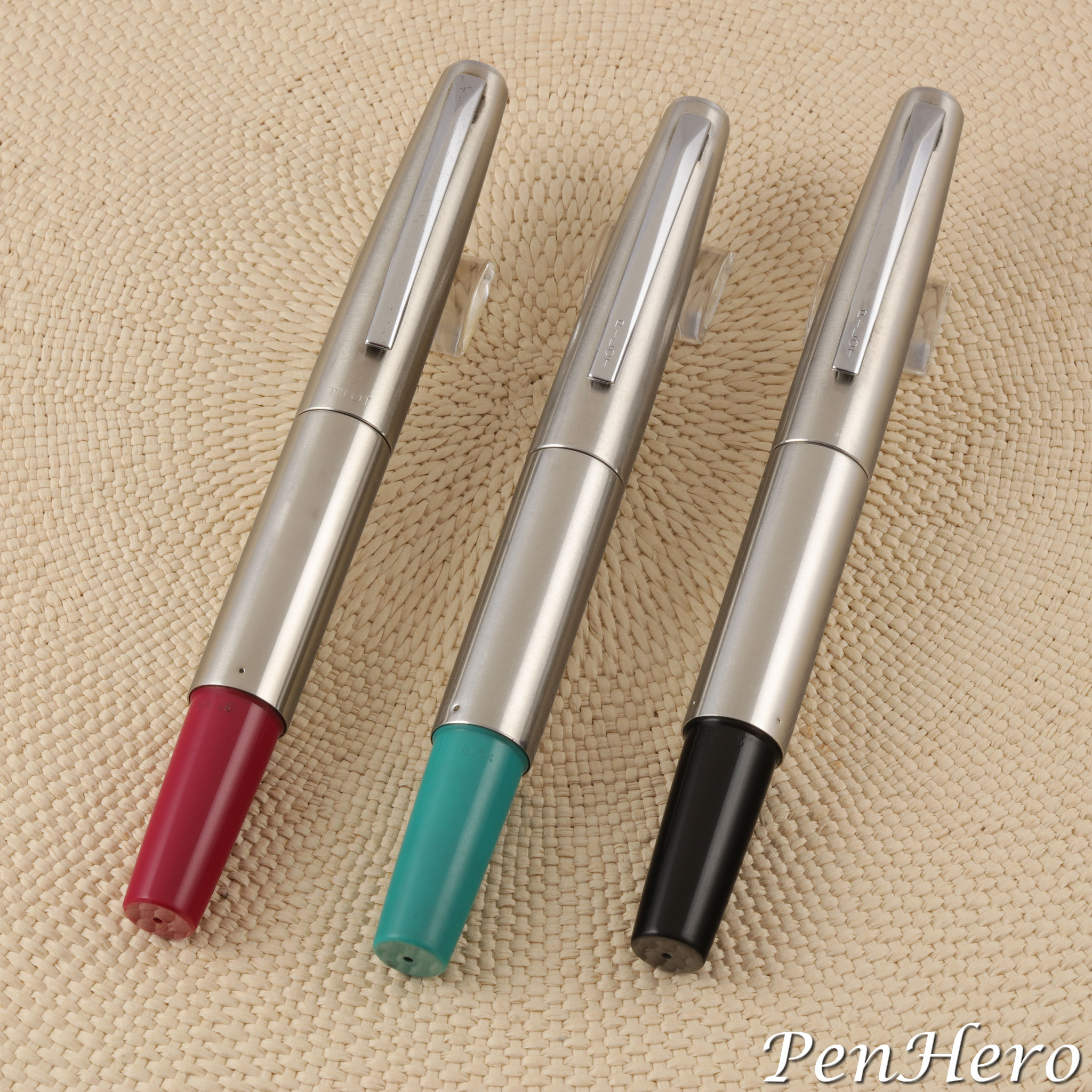 Pilot Short S-150SS fountain pens in red, aqua, and black c. 1966-1969
Pilot Short S-150SS fountain pens in red, aqua, and black c. 1966-1969
At first, visually, it’s a pretty spartan design. Plain steel, solid colors, and a tiny, hooded gold nib. The clip is flexible and will grip onto most dress shirts. The fun part happens when the cap comes off. Or maybe with it still on. Pulling the cap off will usually extend the section, but not always if done gently. Sometimes it’s not immediately clear that the section is fully extended if you’re not paying attention. Post the cap and the pen has a nice, comfortable writing length.
One of the Pilot Short fountain pens tested included a squeeze type Pilot converter with the press bar stamped PRESS HERE over PILOT MADE IN JAPAN. I’ve read several sources that say the pens originally used the early quarter turn Pilot converter, but I don’t have a primary source from Pilot company documents.
Since the red Pilot Short came with a squeeze converter, I decided to take it out for a test write. Filling is the same job as with any cartridge / converter pen, remove the cap, unscrew the section, dunk the nib in ink, and squeeze for 4-6 times. The nib turned out to be a very firm extra fine or needlepoint. On paper, it writes with a slender and moderately dry line. It was a bit on the draggy side, not quite scratchy, but not that smooth, either. The culprit appears to be almost no tipping material and a very tiny sweet spot. I could find the best writing angle to get a smooth line, but it required holding the pen in a specific position. This one could use some tweaking. The other two examples I had dry wrote quite nicely, and the nibs appear to be fine, so maybe they have a larger spot touching the paper. The extended size capped made holding the pen similar to a Parker 45, thin, a bit short, but a good feel in the hand.
Pilot Short fountain pens like this one only came in a few colors and a couple of variations. It appears that they were only made for three or four years. They are overshadowed by the fancier and more colorful short pens offered in the same period. It’s really the telescoping section feature that makes them interesting. They are a little uncommon, but not expensive to acquire. It would be a fun challenge to find all the colors with all three cap markings.
Acknowledgements
I would like to thank Bruno Taut for providing a four page document that illustrates and details all the variants of the Pilot Short, including date and model information, prepared by a Japanese pen collector he recalls is named Mr. Fukuyo. Bruno Taut provided information and a photo that shows a Pilot Short pen with a cap resembling that of the Pilot Super Ultra pen of 1959 - very interesting! He also provided information on Pilot cartridges, photos of pens (showing the blue one) and scans that were very helpful in completing this article.
I would like to thank Stan Klemanowicz, who coined the term "short to long" as a general shorthand for these types of pens. He also provided information on Japanese pen cartridge development, scans of pens, information on the Sailor Mini, and information on converters that were very helpful in completing this article.
I would like to thank David Rzeszotarski, who provided detailed information on Pilot converters and many comments that were very helpful in completing this article.
Without the help of Bruno, Stan and David, this article would be much less detailed and less complete.
References
"Datation of Japanese Pens. III. Pilot’s Pen Bodies", by Bruno Taut, September 13, 2013, © Copyright 2010-2024, Crónicas Estilográficas
"Identifying A Pilot Pen", Fountain Pen Network, September 5, 2012
Fountain Pens of Japan by Andreas Lambrou and Masamichi Sunami, © 2012 Andreas Lambrou Publishers, Epping, Essex, United Kingdom, pages 83, 147, 230, 236, 332, 336-337
Fountain Pens of the World by Andreas Lambrou, © 1995 Andreas Lambrou, Zwemmer, London, United Kingdom, page 362
Fountain Pens of the World by Nakazono Hiroshi, © 2001 Nakazono Hiroshi, Ribun Satobun Publishing Co., Ltd., Tokyo, Shinjuku-ku, Shinjuku, Japan, pages 123-124
"Origami", by Bruno Taut, May 19, 2010, © Copyright 2010-2024, Crónicas Estilográficas
"Pilot’s 100th Anniversary", © Copyright Pilot Corporation
"Pilot’s 100th Anniversary Gallery", © Copyright Pilot Corporation
"Pilot Telescoping LongShort", Fountain Pen Network, January 23, 2010
"Our History", Sailor, © Copyright 2020, The Sailor Pen Company, Ltd.
"Pilot Short 伸縮短鋼 14k尖", by Wai Tat Jerry, Pocket Pen Chronicle, August 30, 2018, © Copyright 2023
"Sailor Mini", by Bruno Taut, August 13, 2020, © Copyright 2010-2024, Crónicas Estilográficas
Interact
Comments on this article may be sent to the author, Jim Mamoulides


